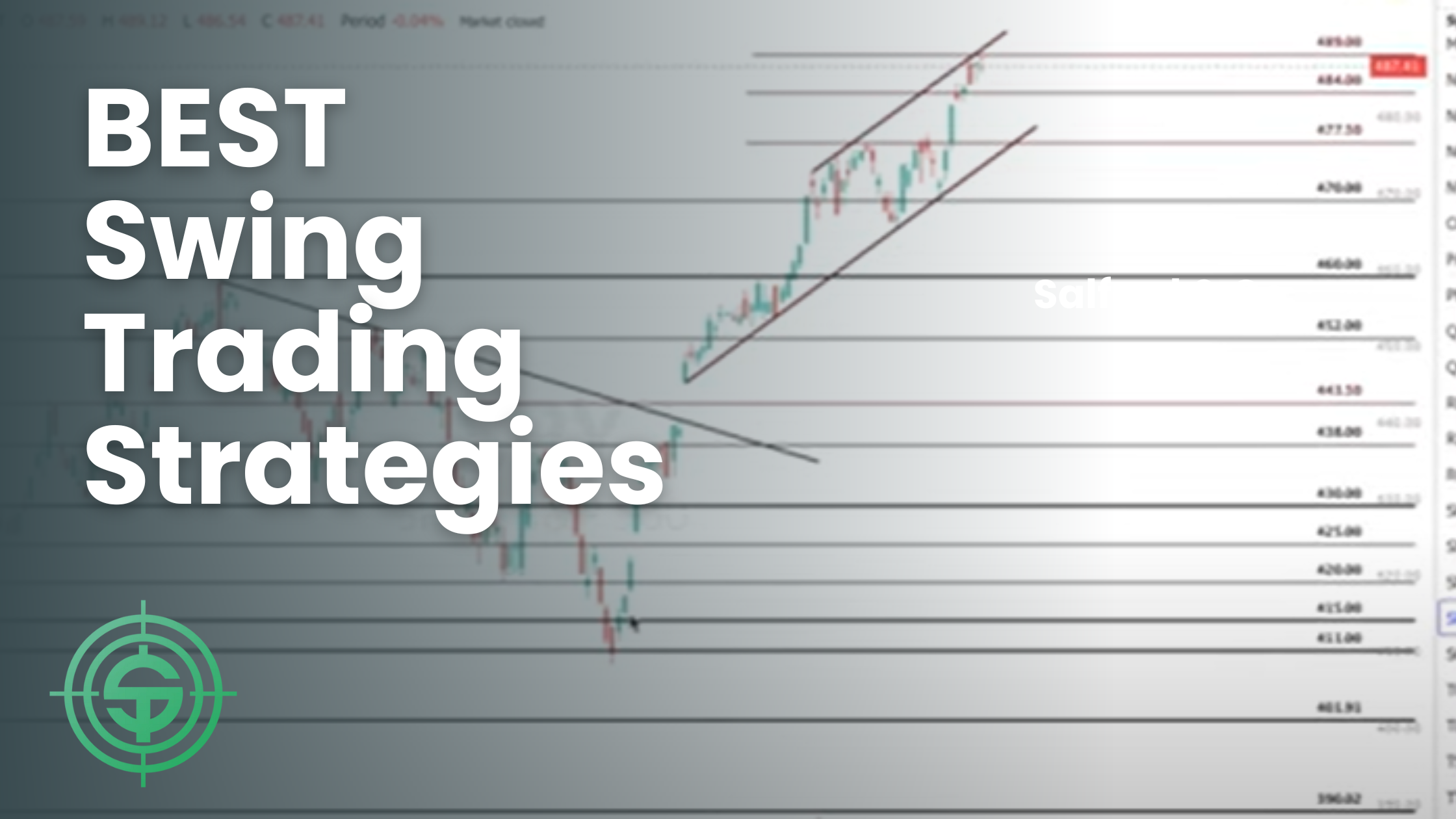
Swing trading is a popular trading style that aims to capture gains in a stock within a short to medium timeframe, typically from a few days to several weeks. This article explores various swing trading strategies designed to significantly increase your profits. By understanding these strategies and applying them effectively, traders can potentially amplify their returns and achieve greater financial success in the markets.
Key Takeaways
- Swing trading combines technical analysis and fundamental insights to target short-to-medium-term gains, distinguishing it from other trading styles like day trading or buy-and-hold investing.
- Effective swing trading strategies involve the use of technical indicators, trend analysis, volume and price action, and risk management techniques to maximize profits and minimize losses.
- Engaging with a trading community and utilizing tools like Sniper Trades can provide valuable insights and support, enhancing the decision-making process for swing traders.
What is Swing Trading?
Defining the Swing Trading Approach
Swing trading is a tactical approach that sits between the rapid-fire scalp trades and the long-term commitment of buy-and-hold investing. As a swing trader, you aim to capture gains in a stock within an over-night to several-weeks time frame. This method requires a blend of fundamental and technical analysis to identify potential trading opportunities.
Swing trading strategies involve holding positions in the market for a period that is longer than a day but shorter than buy-and-hold investing strategies. This unique timeframe allows you to take advantage of ‘the sweet spot’ of market movements, where the potential for profit can be substantial without the need for prolonged exposure to market risks.
To excel in swing trading, you should focus on:
- Recognizing patterns and trends that indicate potential reversals or continuations in price movement.
- Implementing technical indicators to help time your entry and exit points more accurately.
- Managing your trades effectively by setting appropriate stop losses and taking profits at predetermined levels.
Strategy 1: Utilizing Technical Indicators
Mastering Moving Averages for Swing Trading
In the realm of swing trading, moving averages are pivotal in determining the momentum and potential direction of a stock. The simple moving average (SMA) and the exponential moving average (EMA) are two of the most commonly utilized tools. The SMA provides a smoothed analysis of price data over a specific period, while the EMA gives more weight to recent prices, making it more responsive to new information.
To effectively use these tools, consider the following steps:
- Identify the appropriate time frame for your moving average. Common periods include the 9-period EMA for short-term trends and the 200-period EMA for long-term market sentiment.
- Look for crossovers between different moving averages as potential buy or sell signals.
- Combine moving averages with other indicators like the MACD or RSI for a more robust analysis.
By mastering these techniques, you can enhance your swing trading strategy and better navigate the ebbs and flows of the market.
Implementing RSI and MACD in Your Swing Trades
To enhance your swing trading strategies, incorporating the Relative Strength Index (RSI) and Moving Average Convergence Divergence (MACD) can be pivotal. The RSI is a leading indicator that hints at potential future price changes, providing you with an edge in timing your trades. On the other hand, the MACD serves as an oscillating indicator that clearly delineates trend changes, making it easier to spot buy or sell signals.
When combining these indicators, consider the following steps:
- Look for the RSI to indicate overbought or oversold conditions.
- Use the MACD to confirm the trend direction suggested by the RSI.
- Apply a 200-period Exponential Moving Average (EMA) as a long-term support or resistance level, which can further validate your entry and exit points.
By integrating these tools, you can refine your entries and exits, potentially leading to more profitable swing trades. Remember, while these indicators are powerful, they are best used in conjunction with a comprehensive trading plan and proper risk management strategies.
Strategy 2: Trend Analysis and Chart Patterns

Identifying Profitable Chart Patterns
To excel in swing trading, recognizing profitable chart patterns is crucial. These patterns serve as a roadmap, indicating potential price movements and providing you with the opportunity to make informed decisions. Chart patterns are the language of the market, and learning to speak this language fluently can significantly enhance your trading performance.
Start by familiarizing yourself with common patterns such as the bull flag, which signals a continuation of an upward trend after a brief consolidation. Another key pattern is the flat top breakout, where an entry is made as the price surpasses a resistance level, often leading to a swift upward movement. It’s essential to understand the nuances of these patterns, including entry points, stop loss levels, and profit targets to maximize your trades.
Always aim for a favorable profit-to-loss ratio; a common benchmark is 1:2, meaning you risk $1 to potentially make $2. This ratio ensures that even if you’re right only a third of the time, you can still be profitable. By mastering chart patterns and applying them with discipline, you’re setting the stage for swing trading success.
Related: Discover the Top Charts for Profitable Swing Trading
Strategy 3: Volume and Price Action
Analyzing Volume to Confirm Trends
In swing trading, volume can be a powerful ally. Volume bars on your chart represent the number of shares traded within a specific timeframe, such as 5 minutes. A sudden spike in volume can indicate a strong buyer or seller interest, often preceding a price movement.
When you combine volume analysis with a 9-period Exponential Moving Average (EMA), you create a robust framework for gauging market sentiment. If a stock is trading above the 9-period EMA, it’s generally considered bullish, while trading below can signal bearish conditions.
To refine your strategy, consider the following steps:
- Monitor volume bars for significant changes during your trading period.
- Apply the 9-period EMA to identify potential support levels.
- Correlate volume spikes with price action to confirm trend strength or weakness.
By integrating volume analysis with other trading indicators, you create a multi-dimensional approach to swing trading. Remember to combine these tools with solid risk management techniques to enhance your chances for successful long-term trading.
Price Action Techniques for Swing Traders
Price action trading is a cornerstone of swing trading strategies, focusing on the movement of prices to make trading decisions. By analyzing how prices have moved in the past, you can anticipate future market movements and make informed trades. This approach relies heavily on chart patterns and price movements rather than solely on technical indicators.
To effectively use price action techniques, consider the following steps:
- Identify key support and resistance levels where price reversals may occur.
- Look for price patterns such as triangles, flags, and double tops that signal potential breakouts or reversals.
- Pay attention to candlestick formations, as they can provide valuable insights into market sentiment.
Remember, price action trading isn’t about predicting exact market movements; it’s about recognizing probabilities and managing risk accordingly. With practice and attention to detail, you can refine your swing trading to better capture market trends.
Related: Master the Art of Swing Trading: A Beginner’s Guide
Strategy 4: Risk Management Techniques
Setting Stop Losses and Profit Targets
In swing trading, setting stop losses and profit targets is crucial for preserving capital and locking in gains. Establishing a stop loss based on a premium price is a straightforward risk mitigation strategy. For instance, if you collect an $11 premium to open a trade, consider setting a stop loss at two or three times that amount to prevent losses from escalating.
Determining your exit points is equally important. If the underlying price dips below a certain trigger point, it may be time to close the trade. This decision hinges on the severity of the move and its implications for your position. Remember, the goal is to minimize losses, which in turn reduces the amount you need to recoup to stay profitable.
Finally, your position sizing plays a pivotal role in risk management. Deciding whether to add to winners and adjusting protective stops are subjective choices that should align with your overall trading strategy. By adhering to these principles, you can maintain control over your trades and enhance your chances for success.
Understanding Position Sizing and Diversification
In the realm of swing trading, position sizing and diversification are your safeguards against the unpredictable nature of the markets. Your position size should be a reflection of your risk tolerance and the level of confidence you have in a trade. It’s about finding that sweet spot where you’re investing enough to see significant returns, yet not so much that a loss would be devastating.
Diversification, on the other hand, is your strategy for not putting all your eggs in one basket. By spreading your investments across various sectors, asset classes, or even trading strategies, you reduce the risk of a single event wiping out a significant portion of your capital. Remember, diversification is not just about the number of stocks you own, but also about the correlation between them.
- Assess your risk tolerance and set a maximum percentage of your capital to invest per trade.
- Allocate your investments across different sectors and asset classes to mitigate risk.
- Monitor the volatility of your portfolio and adjust your positions accordingly.
- Use stop-loss orders to protect your capital and take profits at predetermined levels.
By adhering to these principles, you can manage your risk effectively and position yourself for long-term success in the swing trading arena.
Related: Maximize Your Earnings with These Expert Swing Trading Tips
Using Sniper Trades Tools and Community
Leveraging Community Insights for Swing Trading
In the dynamic world of swing trading, tapping into the collective wisdom of seasoned traders can be a game-changer for your strategy. By engaging with a trading community, you gain access to a wealth of knowledge and experience that can help you identify trends and make informed decisions. Utilize forums, social media groups, and trading platforms to share insights and discuss strategies with peers.
When you’re part of a community, you’re never alone in interpreting market signals. You can benefit from real-time discussions about momentum trading, range trading, and other strategies that seasoned traders are using. This collaborative environment allows you to cross-verify your analysis and refine your approach.
Remember, while community insights can be incredibly valuable, it’s essential to conduct your own research and stay true to your trading plan. Use the community as a sounding board, not a crutch. The goal is to enhance your swing trading skills and, ultimately, your profits.
Embark on your trading journey with Sniper Trades, the premier community for traders seeking to enhance their market skills and knowledge. Our platform offers a wealth of resources, including educational content, live alerts, and a supportive community to help you navigate the complexities of the stock market. Whether you’re a seasoned trader or just starting out, Sniper Trades provides the tools and insights you need to make informed decisions and execute profitable trades. Don’t miss out on the opportunity to join the fastest-growing Discord group for traders.
Visit our website now to explore our services and plans, and sign up for a trial membership to experience the Sniper Trades advantage firsthand!
Conclusion

Swing trading offers a dynamic approach to the markets, allowing traders to capitalize on short to medium-term price movements. By employing strategies such as technical indicators, trend analysis, chart patterns, volume and price action, and robust risk management techniques, traders can significantly enhance their profit potential. While strategies like momentum and contrarian trading provide avenues for gains, it’s imperative to remember that no approach guarantees a tenfold increase in profits. Success in swing trading requires discipline, continuous learning, and an understanding of market nuances. Tools like Sniper Trades and engaging with trading communities can offer additional insights and support. As always, thorough research and a well-thought-out trading plan are the bedrock of any successful trading endeavor. Remember, the goal is not just to win but to win smartly by minimizing risks and maximizing opportunities.
